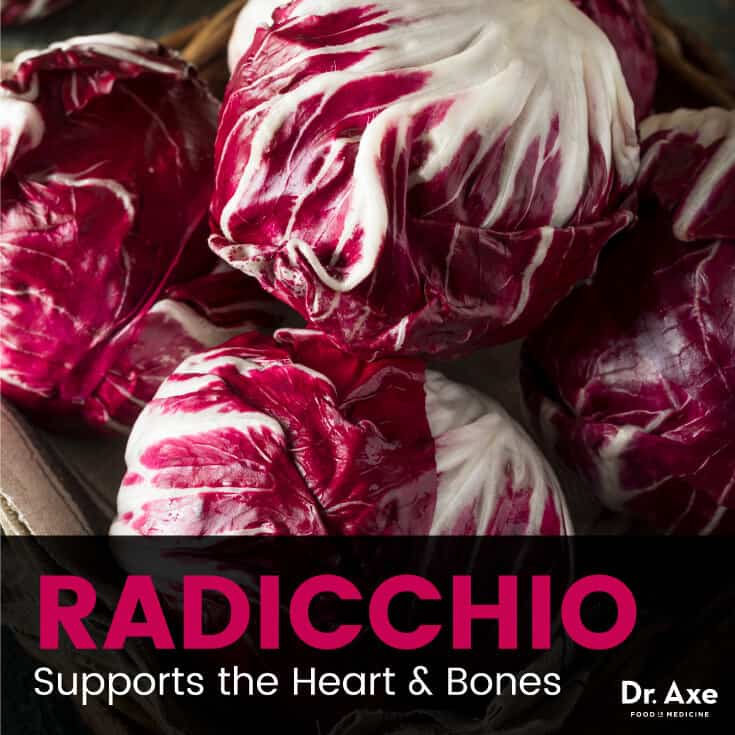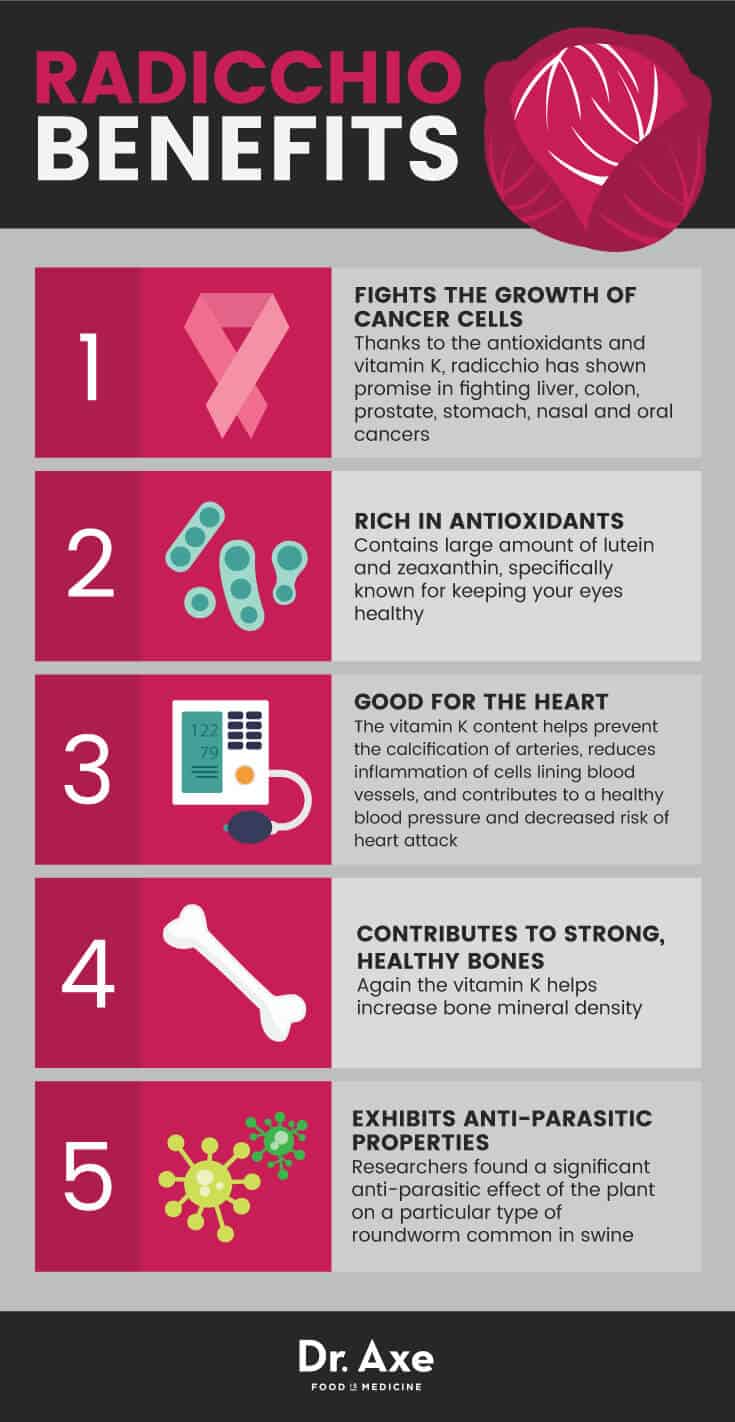
Looking for a striking way to up your salad game? Then it might be time to consider the flavors of a radicchio salad, straight from the farms of Italy.
With a small calorie count but a great spread of nutrients, radicchio is a lesser-known leafy vegetable that’s excellent for your health as well as your recipes. It’s got a ton of vitamin K, a high level of antioxidants and may even help prevent certain cancers. Check it out.
What Is Radicchio?
So, what is this plant that looks deceptively like red cabbage? Radicchio is the Italian word referring to the cultivated leaf plants of chicory, specifically found in Italy. Its characteristically bitter taste makes it a welcome ingredient in fresh salads, and it also pairs well sautéed with various other ingredients. At only nine calories per cup (one serving), it’s a great, flavorful addition to recipes for those trying to lose or maintain weight.
While the price tag can be a bit high, you don’t need a lot of this delicious ingredient to create a great punch in your dishes — plus, it’s an excellent source of nutrition with proven health benefits.
Radicchio has been known as a healthy food for quite some time. In fact, Pliny the Elder, a Roman author and natural philosopher, claimed in his encyclopedia, “Natural History,” that it was useful to purify the blood and treat insomnia. (1) While this document was written during the first century, it’s actually true that one nutrient found in the radicchio plant, intybus, is a mild pain reliever and sedative. (2)
Regular cultivation began in the 15th century and continues today. In 1977, New York Times food editor Craig Claiborne “discovered” radicchio on a trip to Italy, after which this handy ingredient found its way into many Western kitchens and restaurants. (3)
You may be surprised by how incredibly beneficial this leaf (neither a lettuce nor a cabbage, but delicious all the same) can be for your health.
5 Benefits of Radicchio
1. Fights the Growth of Cancer Cells
If you spend much time here, you probably know that I’m a firm believer in treating disease with nutrition, and that’s no different when it comes to cancer. There are many natural treatments for cancer, and I find that a large majority of whole, life-giving foods are often associated with a reduced risk of specific cancers or hold potential cancer-killing benefits. This one is no different.
For people with liver cancer, a regular radicchio salad may be just what you need on your meal plan. The antioxidants contained in this vegetable have been found to fight a particular, very common liver cancer cell known as Hep-G2. Interestingly (but not at all surprisingly), when the chicory plant is fertilized without being exposed to pesticides, the antioxidants that fight this line of cancer are found in higher quantities, meaning it’s worth it to buy this food organic whenever possible. (4)
In a study regarding an extract of chicory, researchers discovered a significant effect on colon cancer, particularly in the early stages of cancer onset. The results suggested the plant-based sugars found in radicchio, known as fructans, may serve to reduce the risk and/or impact of colon cancer. (5)
Radicchio also contains one of the highest amounts of vitamin K in one serving that you can find. Vitamin K is known to reduce the risk of prostate, colon, stomach, nasal and oral cancers.
2. Rich in Antioxidants
The antioxidants found in chicory are useful for more than just fighting cancer. When fighting free radical damage, radicchio exerts a repairing effect on specific kinds of liver injury caused by oxidative stress. (6)
Radicchio also contains a large amount of lutein and zeaxanthin, which are specifically known as the antioxidants responsible for keeping your eyes healthy. At 3.5 grams per serving, this leafy plant is surpassed by only about four other foods when it comes to the presence of lutein.

3. Good for the Heart
The radicchio plant is known as one food found in large amounts in the Mediterranean diet, a lifestyle of delicious foods that has been praised for its ability to help manage weight and fight disease while still providing filling, yummy meals. This diet is also known to support a healthy heart, reducing the risk of heart disease by as much as 30 percent and the risk of sudden cardiac death by 45 percent. (7)
While there are many factors that contribute to the health of this diet, it turns out that radicchio may be one unsung hero in the ability of the Mediterranean diet to keep your heart healthy. In a rat study, scientists discovered that chicory exhibited heart-protecting effects, including reducing lesion size on damaged hearts, reducing inflammation and decreasing cholesterol levels within the heart. (8)
Vitamin K is also a contributing factor to the benefits of this vegetable for the heart. Vitamin K helps prevent the calcification of arteries, reduces inflammation of cells lining blood vessels, and contributes to a healthy blood pressure and decreased risk of heart attack.
4. Contributes to Strong, Healthy Bones
Another benefit of radicchio is its ability to help your body build and maintain strong bones. This is due, in part, to the high presence of vitamin K in every serving. Vitamin K is useful in the treatment and prevention of osteoporosis as it helps to increase bone mineral density. This nutrient also allows your body to better absorb calcium, which is also important when building dense bones. (9)
5. Exhibits Anti-Parasitic Properties
In a pilot study in 2016, radicchio was studied in regard to its impact on parasites. Researchers found a significant anti-parasitic effect of the plant on a particular type of roundworm common in swine. This discovery may indicate a potential benefit of the plant to fight other parasitic growths. (10)
Radicchio Nutrition Facts
Radicchio, or Cichorium intybus, is also known as Italian chicory. Although a serving size is one cup, you can double that for a huge nutritional payload if you’re in the mood. This is an excellent food item to eat as part of a weight loss regimen, as it only contains nine calories per serving but a fairly decent number of vitamins and minerals.
One serving of radicchio (about one cup or 40 grams) contains about: (11)
- 9.2 calories
- 1.8 grams carbohydrates
- 0.6 gram protein
- 0.1 gram fat
- 0.4 gram fiber
- 102 micrograms vitamin K (128 percent DV)
- 0.1 milligram copper (7 percent DV)
- 24 micrograms folate (6 percent DV)
- 3.2 milligrams vitamin C (5 percent DV)
- 0.9 milligram vitamin E (5 percent DV)
- 121 milligrams potassium (3 percent DV)
- 0.1 milligram manganese (3 percent DV)
Radicchio vs. Red Cabbage
How does radicchio different than red cabbage? Because they look similar to the naked eye, it’s not uncommon to confuse the two. However, radicchio is neither a lettuce nor a cabbage, and their nutritional benefits differ in several ways. Red cabbage is also a much less bitter-tasting veggie than radicchio.
Here’s how the two nutritionally:
Total Nutrients
Red cabbage contains a larger number of vitamins and minerals per serving than radicchio. Nutrients found in red cabbage that are not found much in radicchio include protein, vitamin A, vitamin B6, thiamine, riboflavin, calcium, iron and magnesium.
Conversely, radicchio contains sodium and copper, which are not found much in red cabbage.
Vitamin K
One serving of red cabbage contains about 42 percent of the daily recommended value of Vitamin K, whereas radicchio contains 128 percent.
Vitamin C
The amount of vitamin C in red cabbage is worth 85 percent of the daily recommended value, whereas radicchio contains only about 5 percent of what you need each day.
Physical Attributes
While they do look similar, radicchio and red cabbage are slightly different visually. Red cabbage is more purple in color, with a rounder shape than radicchio, which is more maroon and elongated. Radicchio weighs less and has more tender leaves than red cabbage’s waxy, thick ones.
Flavor Profiles
Red cabbage and radicchio have incredibly different flavors and can’t be used interchangeably. The deep, earthy flavor of red cabbage is best in slaws or when slow-cooked to perfection. On the other hand, the bitterness of radicchio really pops in salads or as a pizza topping, and is often softened with salty or sweet flavors.
Cost
Red cabbage generally sells in the U.S. for less than $1 per pound, whereas radicchio costs between $5–$8 per pound.

How to Find and Select Radicchio
There are a few common varieties of radicchio sold in the United States. These include Chioggia, Treviso and Verona. It’s also possible to grow them in a home garden; however, if you do so, you must make sure to properly blanch them.
When selecting a healthy head of radicchio at the store, look for bright, wine-colored heads with obvious midribs. Avoid anything with cracked or bruised leaves.
The varieties also differ slightly. The leaves of the Verona cultivar are loose, whereas Chioggia and Treviso are more tightly compact. After bringing your new veggie home, store it in a refrigerator below 46 degrees Fahrenheit for up to three weeks before cooking and eating.
Radicchio Preparation and Recipes
When prepping your radicchio, begin by cutting off the outer leaves (similarly to cabbage), then rinse the head and cut into halves, then quarters. Depending on the flavor you seek, you can either eat it raw (in radicchio salad or other cold dishes) or cook it in a huge variety of recipes. Cooking will mellow the sharp, bitter flavor of the cold leaves.
Interested in a radicchio salad? Check out this Tricolor Salad Recipe for a combination of excellent flavors and colors that’s also packed with antioxidants.
It can also be served as a yummy side dish by quartering it and roasting it with balsamic vinegar, then garnishing with parmesan cheese. Try Roasted Radicchio next to an Italian dish for a taste that’s sure to pop.
Or, for a filling main dish, you can try the Radicchio and Mushroom Chicken Roulade. It puts a fun spin on a regular chicken breast and throws in the immunity-boosting power of mushrooms.
Precautions
Like any food, it’s possible to suffer an allergy to radicchio. If you experience swelling of the mouth or throat, itching of your lips, or any other allergic reactions after consuming this vegetable, stop eating it and consult a physician immediately.
There’s one commonly assumed precaution when it comes to chicory. One online search will reveal many pregnancy-related warnings regarding chicory. However, upon further investigation, it’s not possible to find any medically or scientifically defining proof that this is a legitimate concern. So talk to your health care provider if you’re pregnant or breast-feeding if you have any concerns with this vegetable.
Final Thoughts on Radicchio
- Radicchio is an Italian vegetable with a wine-red color and elongated shape.
- This veggie has been around for a millennia but has only been found more commonly in the U.S. for about the last 40 years.
- This chicory-based vegetable has various cancer-fighting properties and helps cause cell death in liver and colon cancer cell lines. The high presence of vitamin K found in it means it also may help prevent several other types of cancer.
- There’s a great antioxidant load found in this plant, especially when it comes to lutein and zeaxanthin, the eye health antioxidants.
- It can help you keep your bones and heart healthy.
- Radicchio looks similar to red cabbage at first glance, but they’re significantly different vegetables.
Read Next: Keto Diet Food List, Including the Best vs. Worst Keto Foods
From the sound of it, you might think leaky gut only affects the digestive system, but in reality it can affect more. Because Leaky Gut is so common, and such an enigma, I’m offering a free webinar on all things leaky gut. Click here to learn more about the webinar.
